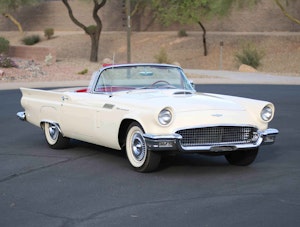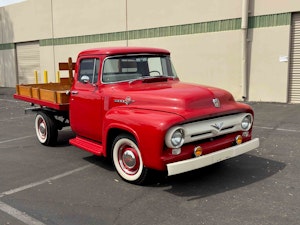Media | Articles
State of the market: Winter 2010
By now, all of us are aware that U.S. households lost 50 percent to 60 percent of their wealth from mid-2007 to March 2009 through a combination of the meltdown in financial markets and plunging real estate values. Even with the “blast off” rally of the past nine months, the loss of net wealth stands at 25 percent to 30 percent on average. The national unemployment rate is hovering around 10 percent, the highest in 26 years, reflecting the loss of almost 7.5 million jobs. Housing prices are off 20 percent to 50 percent depending on which part of the country you live in.
Those who witnessed the battering of their home prices and portfolio values hoped that their collector cars would be absolute stores of value — immune to the recession and subsequent economic turmoil that unfolded in October 2008. They soon realized that this was not going to be the case. Early 2008 was clearly the peak of the collector car market and by October of that year, it was clear that the market was trending rapidly downward, with the most precipitous declines in the muscle car market.
A good portion of the money that flowed into the muscle car market in 2004-2008 was fueled by “wealth” created by real estate. Home equity (and individual borrowing power) increased as values soared. Much of this “wealth” was generated outright by speculation in the real estate market. Individuals with small businesses connected to the housing industry prospered as well — pavers, dry wall contractors and excavators in many cases morphed into full-fledged homebuilders.
As the housing market began to collapse, individuals whose businesses were in any way connected to the real estate industry stopped buying collector cars. That was only the beginning. With many collectors finding that their traditional sources of business credit had dried up, some looked to other assets, such as cars, to provide some liquidity to keep their businesses afloat. As the situation worsened, a lot of forced sales took place, often at a loss.
Muscle cars suffered the worst drop in value for two reasons: First, in the opinion of many, they had simply increased in value too substantially and too quickly for the market to be sustainable. Second, European buyers blessed with a strong euro were not particularly interested in American muscle cars, denying the market the safety net of other sectors of the collector car market. The muscle car market is now down about 40 percent, or roughly back to where it was in 2004.
Marketplace
Buy and sell classics with confidence
Other areas of the collector car market fared considerably better. Blue Chip European sports cars and pre-war full classics in No. 1 condition and with air-tight provenance have barely budged. In fact, robust auction sales at the very top of the market are currently making the overall collector car market appear less affected by the economic downturn than it actually is.
In spite of the recent downturn, collector cars have outperformed the real estate market and the stock market handily over the last four years. The Dow is down more than 20 percent from its October 2006 level and the median U.S. home price is almost 10 percent lower from the same period. Blue Chip collector cars, although down from their early 2008 peak, are still worth 58 percent more than they were four years ago. Only gold is doing better, up 60 percent in two years.
With the exception of muscle cars, much of the recent downward movement in collector car prices was caused by external economic factors. Unlike the speculator-fueled total collapse of the collector car market in 1991, there is little systemically wrong with the collector car market as a whole, which has led many to speculate that the eventual recovery of the collector car market will be fueled by a general economic recovery. That said, indicators are mixed as to how robust and how quick the overall economic recovery will be.
The likelihood of a jobless recovery in the near term remains low with pundits estimating the economy will stabilize by the end of 2009 and produce moderate growth beginning in 2010. Nationally, home prices rose in the second quarter of 2009, the first increase since 2006. Home construction starts are up compared to 2008 and capital, although restricted by more stringent bank underwriting, is beginning to flow again. The 3 percent growth in gross domestic product in the third quarter is likely short-lived as each of the last six recessions have witnessed a rise in GDP in one quarter only to be followed by negative growth the next quarter. Full-year 2009 GDP growth is expected to be negative 2.5 percent.
The recovery will be real once the market gains shift to more selective, better-quality stocks. Consumers want more safety, capital preservation, lower investment fees and more transparency. Later in 2010 as Federal Reserve policy warrants, investors are expected to push toward fixed economic investments and more selectivity in individual stock and equity mutual funds in the near term.
There are parallels in the collector car market. Like the equities market, the collector car market has shifted into a hyper-selective mode. True No. 1 condition cars are in demand at strong prices. However, the gulf between the best and the rest has widened considerably. In Monterey in August, the difference in prices between perfect cars restored by known marque experts and slightly less-than-perfect cars restored by unknowns was profound, as was the difference between strong No. 2 condition cars and No. 3 condition drivers. The latter reflects the amount of time, money and effort that it takes to make a lesser car into a piece of jewelry. The coattails effect that once pushed lesser examples up along with better cars seems gone, perhaps for good.
Just as the recession appears headed to remission, albeit slowly, so too does the decline in collector car prices. Dave Kinney, the publisher of the Hagerty’s Cars That Matter price guide, says the January 2010 edition of his guide shows that collector car prices, like housing prices, seem to be cautiously on the rise.
At the first sign of the stock market rally, investors began speculating when the Dow would be back up to 14,000. As with the Dow, with the first furtive general increase in values, car collectors are now asking when the levels of late 2007/early 2008 will be seen again. In the case of muscle cars, it may be a very long time indeed and any recovery will likely be tied to the strength of the housing market and the economy in general. Remember that it took the Ferrari market until 2008 to regain its former level after the bubble burst in 1991.
The collector car market is also likely permanently changed. Like the antique, coin and stamp markets, particularly well-preserved unrestored cars are likely to remain the most sought after in the future with the gap between the finest examples and questionable examples continuing to grow. Those purchasing collector cars in 2010 and beyond would do well to invest in the best possible examples.










